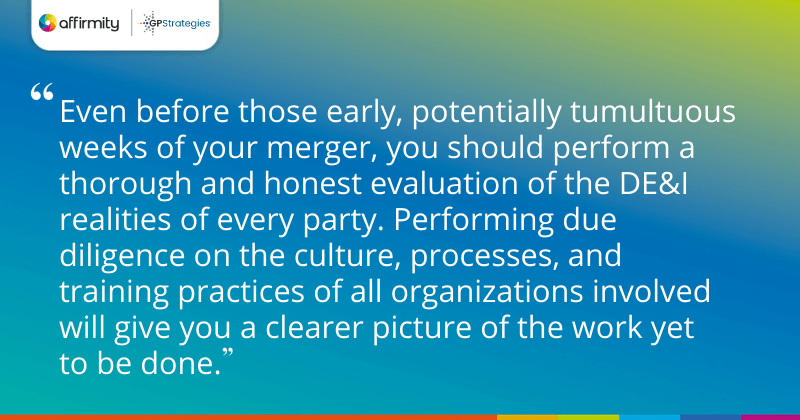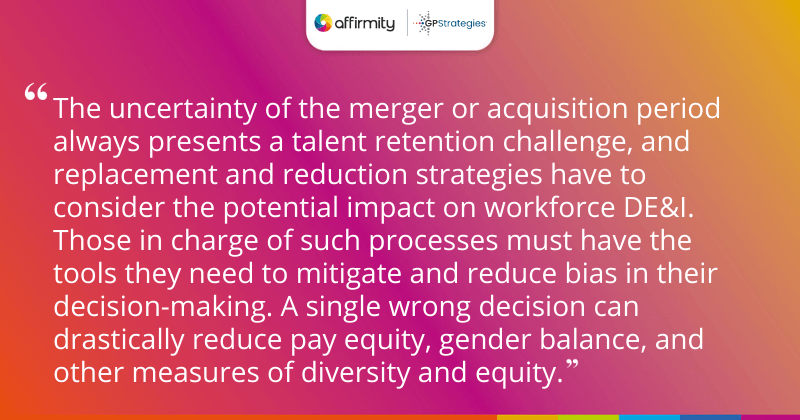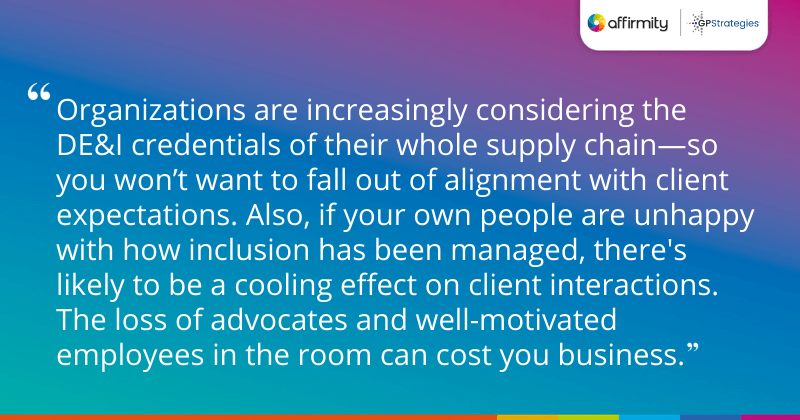Is it ever too soon to talk about DE&I? In this article, Angie Peacock, Director of Global Diversity and Inclusion at GP Strategies (an Affirmity inclusion training partner), argues that it’s never too early to integrate DE&I thinking in a merger or acquisition process.
Mergers and acquisitions can be a source of significant stress and upheaval for any organization. Even when managed well, they’re certain to disrupt employee lives. In this context, diversity, equity, and inclusion can quickly fall off the agenda, with the excuse that everyone is waiting for things to calm down.
However, this period of disruption actually presents a huge opportunity for DE&I. By making the implicit aspects of your workplace culture explicit, you’ll help to ensure that the organization emerging from the merger is a stronger and more inclusive one. But if you fail to exploit the opportunity as early as possible, you may find that hidden biases and assumptions will create issues you’ll be fighting for years to come.

The formula for a successful merger or acquisition includes effective onboarding, as well as clear guidance on attitudes, values, and behaviors. Here are six ways you can seize the opportunity to create a better business.
1) Start Building Better Inclusion With Pre-Merger Due Diligence
Even before those early, potentially tumultuous weeks of your merger, you should perform a thorough and honest evaluation of the DE&I realities of every party. Performing due diligence on the culture, processes, and training practices of all organizations involved will give you a clearer picture of the work yet to be done. It will also help you identify potential culture clashes alongside points of similarity that can be emphasized going forward.
2) Integrate Your DE&I Missions Into Onboarding
If DE&I isn’t integrated into your merger’s onboarding process, you’re making it clear that it’s not a priority for the newly-formed organization. You should use the process to make your expectations around behavior and values clear. You can also use this opportunity to consider whether you have any unspoken, non-inclusive habits, and reflect on how they should change. This could include communication styles, biases exhibited towards certain traits, or wider philosophies at the organizational level that ultimately exclude certain groups.
MORE FROM THE BLOG | ‘The Undeniable Value of Inclusive Leadership and Visible Equity’

3) Be Open About Organizational Differences
When organizations merge there’s hopefully a lot they have in common. However, there are always differences. As these differences slowly emerge in the post-merger period, the discourse around them can become toxic. To avoid this issue, it’s important to respect and celebrate the past—the goal of a merger is to create something greater than the sum of its parts, but that’s only possible when the best aspects of each business are retained.
Nonetheless, you should avoid letting employees unnecessarily cultivate assumptions and biases. One legacy organization could be seen, for example, as the more technically excellent, while the others are seen as the ‘fly-by-night’ consultants—if these ideas get embedded, the real talent in the here and now can get overlooked. One small thing you can do is to encourage everyone to follow some rules that discourage negative assumptions about your legacy organizations. These might include avoiding phrases like: “but this is how we used to do it”, or de-emphasizing which legacy organization a given employee used to be part of.
4) Make Sure DE&I Is Considered When Re-evaluating Talent
The uncertainty of the merger or acquisition period always presents a talent retention challenge, and replacement and reduction strategies have to consider the potential impact on workforce DE&I.
Those in charge of such processes, as well as senior teams and hiring managers, must have the tools they need to mitigate and reduce bias in their decision-making. A single wrong decision can drastically reduce pay equity, gender balance, and other measures of diversity and equity. Inclusion is best served during talent re-evaluations by ensuring that the process is transparent (as far as possible) and well evidenced—otherwise it will be difficult to build trust in your ability to make equitable decisions.
CONSIDERATIONS AROUND PAY EQUITY | ‘Getting Pay Equity Analysis Off the Ground: The First 3 Steps of Your Process’

5) Remember That Clients Are Part of the Equation
Clients will have their own biases about the organizations involved in any merger or acquisition. They may be concerned about whether the new organization will continue to provide the same products and services in the same way, and at the same price points they’ve previously enjoyed. They may also be wary of incoming personnel changes and service disruptions.
Inclusion is a further source of anxiety for some clients during this process. Firstly, organizations are increasingly considering the DE&I credentials of their whole supply chain—so you won’t want to fall out of alignment with client expectations. Secondly, even if working with an inclusive organization isn’t a priority for your clients, your employees may think differently. If your own people are unhappy with how inclusion has been managed, they’re likely to have a cooling effect on client interactions. The loss of advocates and well-motivated employees in the room can cost you business.
6) Expand Your Employees’ Cultural Competencies
DE&I professionals have a role to play in ensuring that everyone has the necessary skills and resources to thrive alongside new cultures. They may need to offer new types of training, or greater support on managing unconscious biases, in order to ease the transition.
YOU MAY ALSO ENJOY | ‘Are You Pulling the 9 “Levers” of Inclusion?’
Can Inclusion Be Simply Mixed and Matched From Merging Organizations?
Many post-merger conversations have, in the past, boiled down to declarations in mission statements and “culture relaunches” solely based on what worked well in each legacy organization. Nowadays, this is at best ineffective—at worst, it’s a strategy-ruining mistake.
Culture must be the driver for post-merger strategies, rather than the other way round. Waiting for things to “bed down” will mean missing a strategic advantage. A program of simple messaging and workshops around inclusion and unconscious bias should be used to help challenge each legacy organization’s assumptions.
This can be further iterated across more in-depth programs that promote robust decision-making around talent selection, appointments, and DE&I-related communications. Only then will you be able to move forward with a strategy that improves upon what came before.
If you would like to discuss how to create a more diverse, inclusive, and equitable organization, please contact us today.
A version of this article originally appeared in Training Journal.
 About the Author
About the Author
Angela Peacock is the Global Director of Diversity and Inclusion at GP Strategies. Through the work of hundreds of clients across 20 years of global DE&I experience, Angela has seen the good, the bad, and the downright idiotic: she pulls no punches and has learned that by having frank, strategic, and not just well-meaning conversations, organizations can drive better results and excel in terms of diversity, inclusion, and business performance.
